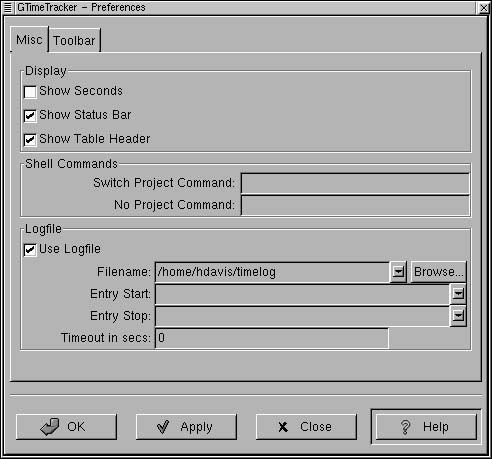Working with GtimeTracker
GTimeTracker, the Gnu time-tracking tool, should not be confused with a full-fledged project management system, such as Microsoft Project. Instead, it is a handy-dandy utility that can be used to track elapsed time and how it is spent.
Figure 7.26. The Gnome time-tracker utility tracks related items–called projects–that are grouped in a configuration.

You could use GTimeTracker simply to better understand how you are using your time. You could also use it to track billable time spent doing specific work. Or you could configure GTimeTracker to open each time you begin a Gnome session (see the following paragraphs). Your computer use could be allocated between work and play, with the results used to report deductibility to the IRS.
GTimeTracker—which was written by Eckehard Berns—groups related projects in configurations. You can have as many configurations as you like.
When a configuration is open and the timer is started, time is allocated to the selected project. This time is tracked with a running total. In addition, total time spent on all projects in the configuration is tracked.
To open GTimeTracker:
-
With the Gnome desktop running, select Time Tracking Tool from the Applications menu fly-out on the Gnome main menu. GTimeTracker will open (Figure 7.26).
Tip
Total elapsed time is displayed in the title bar at the lower left (Figure 7.26).
To toggle the timer:
-
Click the Timer button on the toolbar to start the timer if it is off or to stop the timer if it is on.
Figure 7.27. The Timer Running item on the Timer menu shows whether or not the timer is on.

Tip
The best way to determine whether the timer is on—besides watching for elapsed time to be displayed—is to select the Timer menu. If the timer is on, the Timer Running box will be checked (Figure 7.27). The Timer menu items can also be used to stop and start the timer.
To add a new project to a configuration:
1. | With a configuration open in the time tracker, click the New button on the toolbar or select New Project from the File menu. The Project Properties page will open (Figure 7.28). Figure 7.28. The Project Properties page is used to start a new project.
|
2. | Enter a project title and description. |
3. | If the project has consumed time previously, you can enter this time in the Project Time Today and Project Time Forever fields. |
4. | Click OK. |
Tip
If you edit an existing project using its Properties page, the Project Time Today and Project Time Forever fields will contain the elapsed time that applies to the project.
To change the selected project:
-
With a configuration open in the time tracker, select the project you want to make active.
To record the time-tracking information in a log file:
1. | Choose Preferences from the Settings menu. The Misc tab of the GTimeTracker Preferences dialog box will open (Figure 7.29). Figure 7.29. You can use the Preferences dialog box to set a log file to track time spent on projects.
|
2. | Check Use Logfile. |
3. | Enter a file name and path. |
4. | Click OK. |
Tip
You can use the Browse button to locate the file you want to use to log elapsed time.
To automatically start GTimeTracker with Gnome Desktop sessions:
1. | Choose Session Manager from the Settings fly-out of the Gnome main menu. The Session Manager dialog box will open (Figure 7.30). Figure 7.30. The Gnome Session Manager can be used to start programs automatically when Gnome starts.
|
2. | Click Add. The Add Startup Program dialog box will open (Figure 7.31). Figure 7.31. You can add start up commands directly, or you can browse for the program you want to activate.
|
3. | Enter gtt in the Startup Command box. |
4. | Click OK. GTimeTracker will be added to the Non-Session-Managed Startup Programs list (Figure 7.32). Figure 7.32. Programs that you choose to activate will appear in the Non-Session-Managed Startup Programs list.
|
5. | Click OK. The next time you log on, the time-tracking tool will be started automatically. |





